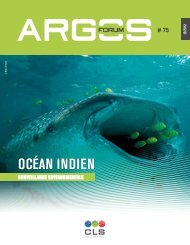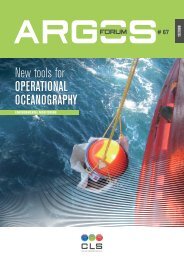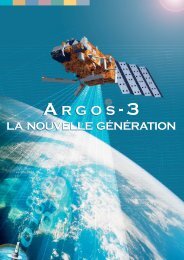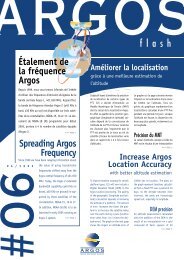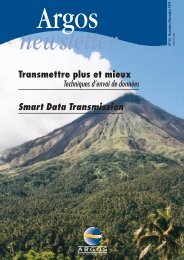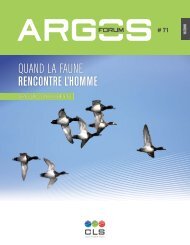INDIAN OCEAN - Argos
INDIAN OCEAN - Argos
INDIAN OCEAN - Argos
- No tags were found...
You also want an ePaper? Increase the reach of your titles
YUMPU automatically turns print PDFs into web optimized ePapers that Google loves.
# 7512/2012© Matthew D. Potenski<strong>INDIAN</strong> <strong>OCEAN</strong>Environmental Monitoring
12/2012 #752CONTENTS<strong>INDIAN</strong> <strong>OCEAN</strong>4 user program 6 user program 8user programSOLVING THEMYSTERYOF SEA TURTLEMIGRATIONin the WesternIndian OceanByJérôme Bourjea, Mayeul Dalleau,Stéphane CiccioneNEW INSIGHTINTO ARABIANSEA OMZ USINGARGO-OXYGENDATABySatya Prakash,TVS Udaya BhaskarSTUDYINGWHALESHARKS INTHE WESTERN<strong>INDIAN</strong> <strong>OCEAN</strong>ByMatthew D. Potenski© Eric Lancelot© Matthew D. PotenskiARGOS Forum is published by CLS (www.cls.fr) ISSN: 1638 -315x – Publication Director: Christophe Vassal – Editorial Directors: Marie-Claire Demmou; Anne-Marie Bréonce; Bill Woodward -Editor-in-Chief: Marianna Childress mchildress@cls.fr – Contributors to this issue Garance Weller gweller@cls.fr - Diane Fastrez dfastrez@cls.fr – Yann Bernard ybernard@cls.com -Debbie Stakem debbie@clsamerica.com - Camille Buzy cbuzy@cls.frDesign: Couleur Citron – Printing: INDIKA ImprimVert certified ISO 14001 - Printed on recycled paper
3#75 12/2012EDITORIALBy Christophe VassalCEO of CLS10PROJEcTSSUSTAINABLEMANAGEMENTOF TUNA IN NORTH<strong>INDIAN</strong> <strong>OCEAN</strong>ByNagaraja Kumar11PROJEcTSThis edition of the <strong>Argos</strong>Forum features the Indian Ocean, one of theworld’s largest oceanic zones and a crucial habitat for marine life.Six species of sea turtles are found in this ocean’s warm waters,whale sharks, dolphins and manatees breed and give birth here andmarine birds are numerous. Fisheries flourish with tuna and shrimp.Oceanographers are keen on understanding the dynamics of thispredominately subtropical ocean and identifying the consequencesof world climate change there. Approximately 2500 <strong>Argos</strong> beaconscollect data from this zone and relay it to users worldwide. But theIndian Ocean, boardered by India in the Northeast, is the star of this<strong>Argos</strong>Forum issue not only because of its importance to marine lifeand its role in the climate system but also because it allows us tohighlight India’s contribution to the <strong>Argos</strong> system. As we prepare forthe launch of the fourth <strong>Argos</strong>-3 payload on-board the Indian satellite,SARAL, early 2013, it is the moment to celebrate India’s role in thisinternational scientific system. India joined the OPSCOM, committeethat manages the development and operations of the <strong>Argos</strong> system, in2007, and has been a dedicated partner ever since. Six ground stationsreceive <strong>Argos</strong> data over the area for real time processing. The growing<strong>Argos</strong>-3 constellation promises additional services for users in this zoneand around the world. Enjoy reading about <strong>Argos</strong> system’s contributionto understanding the Indian Ocean.THE ARGOPROGRAM INTHE <strong>INDIAN</strong><strong>OCEAN</strong>ByBy Mathieu Belbeoch andthe Argo Steering TeamAll ARGOS publications are available at:www.argos-system.org
USER programSOLVING THEMYSTERYOF SEA TURTLEMIGRATIONin the WesternIndian OceanByJérôme Bourjea, Mayeul Dalleau,Stéphane CiccioneThe WesternIndian Ocean is a privileged zonefor feeding and egg-laying for greenturtles (Chelonia mydas) and loggerhead turtles (Caretta caretta). Butvery little is known about the turtles’ movements between feeding andnesting sites, which is why the French research institute, IFREMER, andKélonia, the Observatory of Marine Turtles on Reunion Island, launchedan ambitious satellite tag tracking program in the region. The programaims to improve knowledge of the movements of green and loggerheadturtles over time, as well as learn more about the interactions betweenloggerhead turtles and longline fishing. As Jerome Bourjea, MayeulDalleau and Stephane Ciccione explain, the program provides vitalinformation about this iconic species.Sea turtles are no respecters of borders, still lessof Exclusive Economic Zones (EEZs), intergovernmentalagreements or national commitments.And they completely ignore the socio-economicsituations of countries or the financialcrisis afflicting the planet. For the last 110 millionyears, they have been calmly migrating, travellinghundreds and even thousands of kilometersbetween their egg-laying and feeding areas, withno other purpose than to ensure the survival oftheir species. Over the course of these greatocean voyages, they are often affected by humanactivities, sometimes to their advantage, but veryoften quite the opposite is true.This is the case in the Western Indian Oceanwhere turtles and humans are in close contact.There are some major egg-laying sites for green12/2012 #754turtles (Chelonia mydas) in this part of the world,such as the scattered French “Éparse Islands”,the coral islands of the Seychelles or theComoros archipelago. The turtles also have majorfeeding grounds here, mostly consisting of veryabundant seagrass meadows along the coasts ofMozambique, Tanzania, Kenya and Madagascar.We still know little about their movementsbetween nesting sites and feeding grounds.What kind of contact do they have with deep-seafishing activities when out at sea? Which coastalareas do they prefer for feeding, and what arethe threats to their safety? We need answers tothese questions if we are to draw up an effectivemanagement and conservation strategy for theseiconic migratory species.© Eric LancelotLoggerhead turtle (Caretta caretta) caught by a long liner in La Réunion island.The hook was removed and the turtle released with a satellite tag.Figure 1: Since 2009, more than 110 <strong>Argos</strong> transmitters have beendeployed on female green turtles (chelonia mydas) during the reproductionseason at the main nesting sites in the South West Indian Ocean making itpossible to draw up effective conservation strategies.
5#75 12/2012Understanding turtle behaviorIn 2009, the Ifremer Delegation on RéunionIsland (www.ifremer.fr/lareunion) and Kélonia,the Observatory of Marine Turtles on Réunion Island(www.kelonia.org) launched an ambitious satellitetelemetry program to improve our knowledgeof the movements over time of green andloggerhead turtles (Caretta caretta) in theWestern Indian Ocean. Every time these turtlescome to the surface to breathe, as they journeyacross the ocean, the transmitters attached totheir shells use <strong>Argos</strong> beacon technology to sendlive information about their position, via satellite.Over the course of the project, more than 110 <strong>Argos</strong>transmitters have been deployed on laying greenturtles during and around the peak of the egglayingseason at the main reproduction sites inthe region: Europa, Juan de Nova, Glorieuses, Mayotte,Mohéli (Comoros) and Tromelin (Figure 1).The initial analyses show that these turtleshave crossed no fewer than 9 different EEZs ontheir way to their feeding grounds, which areon the coasts of 6 different countries. The EastAfrican coast, from northern Mozambique tosouthern Kenya, together with northernMadagascar, are the principal feeding sites forthis species.Cooperating with fishing fleetIn parallel, and thanks to the willing cooperationof Reunion Island’s fishing fleet, 17 <strong>Argos</strong>transmitters have been deployed on immatureloggerhead turtles caught accidentally by longlinefishing vessels operating out of Reunion Island(Figure 2).The program aims to learn more about theinteractions between longline fishing and youngloggerhead turtles so that measures can be takento reduce its impact. By tracking their movementsthe program has shown that although some of theturtles found in the waters around Reunion Islandand Madagascar migrate to southern Madagascarand the Cape of South Africa, a large majoritymove up into the North-Western Indian Ocean.Over the course of their journeys, during whichsome have covered more than 13,000 km, someeven change hemispheres and spend time in thenorth of the Indian Ocean off Yemen and Oman.A regional approachThe initial results have persuaded the other coastalcountries in the region to adopt the same approach.The South West Indian Ocean Fisheries Project(www.swiofp.net) includes all the countries in theregion that share in these study and conservationinitiatives. In 2012, more <strong>Argos</strong> transmitters willbe deployed on these two species in Mozambique,Tanzania, Kenya, the Seychelles and Mauritius.These will provide further data to confirm theoriginal results and provide regional decisionmakerswith important information for aregional management strategy for this resource,currently categorized as threatened by the InternationalUnion for Conservation of Nature (IUCN).This approach is in line with the IOSEA Conservationand Management Plan (www.ioseaturtles.org),the Memorandum of Understanding on theconservation of marine turtles and their habitatsin the Indian Ocean and South-East Asia, underthe aegis of the Convention on Migratory Species.Jérôme BourjeaJérôme Bourjea runs the DYMITILE project, studying the migratorydynamics of marine turtles in the islands of the Indian Ocean. He has beena researcher at the Ifremer Delegation in Reunion Island in the fields ofconservation biology and fishing for 10 years. His research is focused onthe connections between marine megafauna in the South-Western IndianOcean and how they can be applied to resource management.Mayeul DalleauMayeul Dalleau is the principal agent of the DYMITILE project. He is adoctoral student at the University of La Réunion and through his researchseeks to extend our understanding of the biological and environmentalprocesses influencing the spatio-temporal dynamics of marine turtles.His role is also to imagine how the results of his research could be appliedto the conservation of these threatened species.Stéphane CiccioneStéphane Ciccione is the Director of Kélonia, the Observatory of MarineTurtles on Reunion Island. Stéphane has spent the last 20 years developingprogrammes for the study and conservation of marine turtles in aframework of regional cooperation. The results of these programs are thebasis of a campaign to raise awareness of these issues, organized byKélonia, which welcomes more than 120,000 visitors a year.Figure 2: Thanks to the cooperation of Reunion Island’s longlinerfishing fleet , 17 <strong>Argos</strong> transmitters have been deployed on immatureloggerheads caught accidentally.
USER programNEW INSIGHTINTO ARABIANSEA OMZUSING ARGO-OXYGEN DATABySatya PrakashTVS Udaya BhaskarThe Northern12/2012 #756Indian Ocean, composed of theArabian Sea and the Bay of Bengalis a critical zone to monitor for signs of climate change. Research showsthat oxygen minimum zones (OMZs) are prevalent here, meaning thatmarine ecology and fisheries are threatened long-term. Argo floatsequipped with oxygen sensors provide essential data about dissolvedoxygen concentration in the world’s oceans. In the Indian Ocean, Indiais an important contributor to the global Argo program, having deployedover 100 Argo floats, about one fourth of which collect oxygen data.The data they provide helps scientists such as Satya Prakash and TVSUdaya Bhaskar of INCOIS gain new insight into the seasonality ofoxygen depletion and its implications at different thermocline levels.Figure 1.Time series plot of dissolvedoxygen in the upper 250 mobtained from an oxygensensor-equipped Argo float(WMO ID 2900776)Dissolved oxygen (DO) concentration in theoceanic waters is a key indicator of global climatechange. Recent observations and model studieshave suggested a decline in the concentrationof DO and expansion of oxygen minimum zones(OMZs) in the tropical ocean over the past 50years. It is therefore of utmost importance tomonitor oxygen concentration throughout theworld ocean, particularly in the northern IndianOcean which is one of the three major basinsin the world Ocean which is characterized bypresence of OMZs in its sub-surface waters. Thenorthern Indian Ocean comprises of the ArabianSea in the west and the Bay of Bengal in the east.Both of these basins experience severe oxygendepletion at the sub-surface layer (~150-1000 mdepth) but the vertical extent and strength of theOMZ is more pronounced in the Arabian Sea thanthe Bay of Bengal. In fact the Arabian Sea OMZharbors one of the highest volumes of suboxic(< 5 µmol kg-1) waters.
7#75 12/2012Figure 2.Location of Argo float (WMO ID 2900776)in the Arabian Sea (shown in green). Whiteline shows geographical limits of oxygenminimum zone, outlined by Naqvi et al(1991), demarketed by 1μM NO2− contour.The Argo Program, underway since 2000, providesa suitable platform for monitoring the ocean’sinterior at adequate temporal and spatial scales.The addition of biogeochemical sensors such as fordissolved oxygen and chlorophyll has the potentialto further revolutionize our understanding of theocean’s role in climate change. India has activelycontributed to the global Argo program and hasdeployed Argo floats, equipped with oxygensensors, in the Arabian Sea and Bay of Bengal. Weanalyzed one such Argo float (WMO ID 2900776)deployed by India in the central Arabian Sea anddiscuss here some important results from thisfloat.The DO data from the float 2900776 (http://www.jcommops.org/jcommops-ptf/WebObjects/jcommops-ptf.woa/wa/PtfComponent?code=2900776&prog=Argo) shows presence of a perennialsub-surface oxygen minimum zone in the centralArabian Sea. This not only confirms our existingknowledge on the Arabian Sea OMZ but alsoprovides a detailed closer look at the seasonaldynamics. The new high resolution Argo-oxygendata suggests large variations and strong seasonalityin oxycline depth in the central Arabian Sea.There appears to be semi-annual oscillation in theoxycline depth: it is shallower (~60 m) duringthe months of November-January and deeper(~120 m) during April-May.The oxycline depth shoals up every year duringthe early winter monsoon which indicates intensificationof the OMZ and has been attributed tosluggish renewal during this season. Small phasesof decline in the oxycline, though for relativelysmaller periods, may also be seen during themonths of late February-early March and July-August.This seasonality was not observed during theJoint global ocean Flux study (JGOFS) probablybecause of limitation in analytical techniquesbut they did observe a strong seasonality in theprimary productivity. The presence of oxygendeficient water at a much shallower level hassignificant implications: it can affect nitrogencycling, which in turn can affect the biologicalproduction on a longer time scale. It is also likelyto affect marine ecology and fisheries.Satya PrakashAuthor is a scientist at Indian National centre for Ocean InformationServices (INCOIS), Hyderabad, India. He did his PhD at Physical ResearchLaboratory, Ahmedabad, India where he worked on biogeochemistry of theIndian Ocean. At INCOIS he is involved in analyzing Argo-oxygen data. He isalso executive secretary of SIBER (Sustained Indian Ocean Biogeochemicaland Ecological Research) International Program Office at INCOIS.TVS Udaya Bhaskaris a scientist at Indian National centre for Ocean Information Services(INCOIS), Hyderabad, India. He did his PhD on characterizing the surfacelayers of Arabian Sea using Argo profiling float data at Acharya NagarjunaUniversity, Guntur, India. At INCOIS he is responsible for processing andQuality control both Real Time and Delayed Mode, of all floats deployed byINCOIS as a part of the Indian Argo program. He is also responsible for theArgo Regional Centre (ARC) activities of Indian Ocean.
USER programSTUDYINGWHALESHARKSIN THE WESTERN<strong>INDIAN</strong> <strong>OCEAN</strong>ByMatthew D. PotenskiWhale sharks12/2012 #758(Rhincodon typus) are the biggestfish in the oceans, and canachieve sizes bigger than city buses. They also have a vibrant patternof spots and spend a lot of time swimming near the surface. Despitethese facts, we still know relatively little about the biology of whalesharks. Even simple life history parameters have not yet been verifiedand behaviors such as mating or giving birth have never been observedfor this species. Whale sharks are considered highly migratoryand remain elusive as their size is greatly dwarfed by the vastness ofthe world’s oceans. There are several “hot spots” in the world wherewhale sharks are known to aggregate. Whale sharks have been wellstudied in the Eastern Indian Ocean, mostly based out of the aggregationsite near Ningaloo Reef, Australia. But populations and behaviorsof whale sharks in the Western Indian Ocean have only been lookedat in the last 5-7 years. Around 2005, the Shark Research Institute(SRI) determined that a mostly unknown aggregation of whale sharkswas occurring in the waters off of Mafia Island, Tanzania, and sentMatthew Potenski to find out more.Since 2005, a joint study by SRI and the WWF-Tanzania program Office, has aimed to determinewhale shark abundance, population structure,temporal patterns of usage, and movements. Along-term monitoring program was set up withvisual surveys, ID placard tagging, spot-patternphoto identification, and PSAT deploymenttagging.Whale sharks could be reliably found swimmingand feeding on the surface in waters to thewest of Mafia Island, one of three large Islandsoff the coast of Tanzania. When encountered, awhale shark’s spot pattern was photographed, itssex determined by visual confirmation, its sizeestimated, and its GPS location recorded. Allwhale sharks over 3m total length were taggedwith a plastic ID placard tag, which displayed afour digit ID number.Tracking whale sharksTags were deployed in situ via a specially modifiedspearhead shot from a standard double-bandedspeargun. Encounter periods lasted between30 seconds to 45 minutes, illustrating the shortwindows for observation we have for theseanimals. In response to their elusive natureand our short observation windows, attachmentof archival tag technology was considered anexcellent way to increase observation samplingand observe long –term behaviors. Eight whalesharks (5 male, 3 female, all juveniles 5-7 m totallength) were fixed with Microwave Telemtry PTT-100 pop-off satellite archival tags. The tags wereprogrammed to collect data for a set time interval(in this case 2, 8, or 12 months). At the end ofthe time interval, the tag would pop off its tetherand float to the surface. All the archived datawould then be transmitted to the <strong>Argos</strong> satellitesystem and retrieved by SRI.© Matthew D. PotenskiA whale Shark carrying an <strong>Argos</strong> tagPhoto courtesy of the Shark Research Institute© Matthew D. Potenski
9#75 12/2012MethodThe data was sent in standard <strong>Argos</strong> formatand data from light, pressure, and temperaturesensors was transmitted. Pressure data wasconverted to diving depth profiles. Temperaturedata was plotted. Light level data was coupledwith depth data via algorithms in the R –Networkjava runtime environment extension TRACK-IT.This analysis provided latitude and longitudepoints corrected with a Kalmann (random walk)filter. Track data was plotted on GoogleMapgeo-referenced backgrounds for illustration. Foraccuracy, portions of tracks that were obviouslythe result of error (for example, when the trackhappens to cross over solid land – a physicalimpossibility for whale sharks) were disqualifiedfrom the dataset. Some data were also discardedwhen the sharks were undergoing deep divingbehavior, as the light data was unreliable andlarge error was evident. The resulting tracks werediscontinuous, but they indicate that the sharksuse specific areas of the extent of their travels.ResultsThe results of the PSAT tag data shows twoimportant facets of whale shark movements offof Tanzania. The whale sharks showed evidenceof North-South movements along the Tanzaniancoast and stayed mostly within Tanzanian waters.The largest range for a track was coveringapproximately 1000 km of East African coastline,from Southern Kenya to Northern Mozambique.These sharks also spent a lot of time aroundMafia Island and seemed to spend a lot of timein the shallower waters of the shelf. As juvenilesharks, they may have a limited home range offof Tanzania, and may transition to a more pelagicand migratory lifestyle as they reach maturity.The whale sharks of Mafia also show nointeraction with a population being studied inSouthern Mozambique, which display strongEast-West movements between Mozambiqueand Madagascar. Based upon satellite tag datacollected with the aid of the <strong>Argos</strong> system, it wasdetermined that the whale sharks found off ofMafia are using a smaller area than assumed andthat Mafia Island itself may be essential habitatfor this population of whale sharks in the WesternIndian Ocean.About Shark Research InstituteShark Research Institute (SRI), a multi-disciplinary,nonprofit, scientific research organization,was created to sponsor and conduct researchon sharks and promote their conservation. Itserves the scientific community, individuals andorganizations concerned about the health of ourmarine ecosystem, and marine resource users.SRI works to correct misperceptions about sharksand stop the slaughter of 100 million sharksannually. Current projects include visual andsatellite tracking, behavioral and DNA studies ofsharks, environmental advocacy, publications andpublic education.Learn more: www.sharks.orgMatthew D. Potenski© Kristine StumpMatthew D. Potenski earned a BS from Rutgers University in 2001.He then went on to work for the Guy Harvey Research Institute at theNova Southeastern University Oceanographic Center for several years.Matthew has also worked on many projects for the Bimini BiologicalField Station-Sharklab in the past 10 years. He has been working withthe Shark Research Institute since 2001 and became the Director ofField Operations in 2008. Matthew completed SRI fieldwork on whalesharks in Galapagos, Ecuador and Utila, Honduras before setting up thejoint SRI-WWF research project in Mafia Island, Tanzania. He is lookingto build upon and expand his whale shark work in Tanzania with a newstudy that will fulfill his PhD dissertation. Matthew is based out of NewJersey, USA, but travels frequently for his passions of scientific researchand underwater photography.
projectsSUSTAINABLEMANAGEMENTOF TUNA INNORTH <strong>INDIAN</strong><strong>OCEAN</strong>ByNagaraja Kumar© CMFRI / INCOISTagging a tuna in the Indian Oceanby a team from CMFRIIndian National Centre forOceanInformationServices (INCOIS), an autonomous body under the Indian Ministry of EarthSciences is engaged in ocean observation, modeling, information andadvisory services. In the Indian Ocean, information available on the Tunahabitat preferences and their migration patterns is poor. It is necessary tobuild up such a knowledge base for effective and sustainable managementof Tuna fisheries in the region. In this context, INCOIS initiated a project on“Satellite Telemetry studies of Tuna in the India Seas (SATTUNA)”to track theYellowfin Tuna (Thunnus Albacares) with Satellite tracked Pop-up StandardArchival Tags (PSAT). Central Marine Fishery Research Institute (CMFRI),Fishery Survey of India (FSI) and Centre for Marine Living Resources andEcology (CMLRE), who has wide experience in field operations includingtagging, are the partners of INCOIS in SATTUNA responsible for collectinghydrographical, physical and biological parameters in the seas around India.The main objective of the project is to developcomprehensive baseline data on the environmentaland biological parameters influencing tunahabitat and migration in the Northern IndianOcean. Though the Tuna will be tracked overthe entire Northern Indian Ocean, the taggingoperations will be carried out in the Indian EEZ offVisakhapatnam, Lakshadweep Islands, Chennai,Mumbai and Port Blair.India’s first tuna tagging operationTagging of Yellowfin Tuna with Satellite Pop-upTags is the first of its kind in India and INCOISsuccessfully tagged 20 Yellowfin Tuna (08 tagsoff Visakhapatnam, Andhra Pradesh, 05 Tags offChennai, Tamilnadu and 07 Tags off LakshadweepIslands) during December 2011 – April 2012 withPSAT model X-Tag procured from M/s. MicrowaveTelemetry Inc., USA.Also INCOIS proposed to continue the taggingoperations with PSAT’s during its XII Plan Period12/2012 #7510(April 2012 – March 2017) and had plans to taganother 25 Yellowfin Tuna during October 2012– March 2013 to build up the database. The Taggingoperations will be carried out using fisheryresearch vessels and commercial fishing vessels.ARGOS data telemetry system will be used for thedirect transmission of data to INCOIS.Leading to sustainable management of tunafisheriesThe PSAT tags will provide the data on temperature,depth and light levels along the migratoryroutes of Yellowfin Tuna. The light levels are usedfor underwater geolocation. Additionally, they willprovide information on surface drift once the tagpops up and floats on the surface. The data onthe environment preferred by the Tuna togetherwith the information on their migratory routeswill provide the essential information required forthe sustainable management of Tuna in the seasaround India.
11#75 12/2012projectsIn 1999a small group of oceanographers outlined a plan to setup an array of profiling floats to monitor the state of theupper 2km of the global ocean. The initial objective was to maintain a networkof 3000 units, in ice-free areas, providing both real-time data and higherquality delayed mode data and analyses to underpin new generation oceanand climate models. The program was called Argo.Figure 1. © JCOMMOPS « Lady Amber » sailboat.THE ARGOPROGRAM INTHE <strong>INDIAN</strong><strong>OCEAN</strong>ByMathieu Belbeoch andthe Argo Steering Team.In its short life the Argo data set has become anessential mainstay of climate and ocean modelers,complementing information from Earth observingsatellites, but uniquely providing subsurfaceinformation giving new insights into changes inthe earth’s hydrological cycle and opening thepossibility of seasonal climate forecasting.In late 2012 the Argo array has risen to 3500floats, the largest it has ever been, and theaverage lifetime of the floats has approximatelydoubled in the past decade.Argo floats are gathering profiles of temperatureand salinity (together with information on subsurfacewater movement) at the impressive rate of1 profile approximately every 4 minutes and onNovember 4th 2012 the array passed the symbolicmilestone of collecting its 1 millionth profile.The float that collected the symbolic profile isoperated by the Indian Argo program (INCOIS),(Float # 2901287), and helps in understandingmonsoon rainfall seasonal patterns.Since Argo’s beginning, the INCOIS is responsiblefor maintaining a large part of the Argo array inthe Indian Ocean (about 100 floats, see picture,fuchsia color) together with Australia, USA andother Argo nations.Recently, the Australian Argo program, withJCOMMOPS help, launched an innovativepartnership with a South African education sailingship, Lady Amber, for the deployment of 50 floatsin parts of the Southern Indian Ocean that areseldom visited by research or cargo vessels . Thisoriginal approach to floats deployment is beingduplicated in other areas, as the research vesselsand merchant ships that traditionally launchedfloats for the Argo program have become lessavailable in the current global economic crisis.JCOMMOPS will look more and more towardsestablishing partnerships with “green” and nonprofitbased deployment platforms. These includesailing communities, NGOs, individual explorers,etc.In addition, a large part of the IO (North Westquarter) is almost closed to float deploymentsbecause of piracy issues. Scientists will haveto explore some more options to ensure the IOremains properly covered.The Lady Amber will be back in Cape Town soonand will load 50 more units from NOAA (andsurface drifters) for deployment in the SouthAtlantic Ocean and Gulf of Guinea.The JCOMMOPS Centre has also just hired a newcoordinator to further develop those partnershipsand regional chartering services. It will continueto assist Argo scientists; who need to deploy morethan 800 units worldwide every year (including100-150 in the Indian Ocean). The logisticalchallenge for Argo is continuous.JCOMMOPS thanks CLS sales department forsupporting the administration of the JCOMMOPS“Ship Time Service”.3618 actives floats –October 2012Figure2. Lady Amber is tracked in real time through a CLS GPS beacon (MAR GE V2).
WE WELCOMEYOUR CONTRIBUTIONS!We know your work is interesting.Let us publish it!We are currently accepting contributions.Articles (maximum 700 words) shouldbe submitted in French or English.Email: mchildress@cls.fr | cbuzy@cls.frHeadquarters CLS8-10, rue Hermès, Parc technologique du Canal31520 Ramonville Saint-Agne, FranceTel.: +33 (0)5 61 39 47 20Fax: +33 (0)5 61 39 47 97E-mail: info@cls.frwww.cls.frNorth America: CLS America Inc.4300 Forbes Boulevard, Suite 110Lanham, MD 20720, USATel. +1 301 925 4411Fax + 1 301 925 8995E-mail: userservices@clsamerica.comwww.clsamerica.comPerú: CLS PeruJr Trinidad Moran 639Lince Lima, PerúTel. +51 1 440 2717 Fax. +51 1 421 2433E-mail: cvillaran@clsperu.com.peChile: Cunlogan S.A.Almirante Señoret 70 of 74Valparaiso, ChileTel. +56 32 225 28 43Fax +56 32 225 7294E-mail: cbull@cunlogan.clBrazil : ProoceanoAv. Rio Branco, n° 311 - sala 1205,Centro - Rio de Janeiro – RJ,5CEP: 20040 – 009 - BrazilTel.: +55 21 2532.5666E-mail: contato@prooceano.com.brWeb: www.prooceano.com.brSouthEast Asia: PT CLS IndonesiaK-Link Tower, Fl. 25 Suite AJl. Gatot Subroto, Kav 59 AJakarta Selatan, 12950, IndonesiaTel. +62 21 29 02 69 55Fax +62 21 29 02 69 45E-mail: sales@clsargos.co.idJapan: Cubic-I Ltd.Bluebell Bldg. 7F2-15-9 Nishi-GotandaShinagawa-kuTokyo 141-0031, JapanTel. +81 (0)3 3779 5506Fax +81 (0)3 3779 5783E-mail: argos@cubic-i.co.jpSix ground stations receive <strong>Argos</strong> data over thearea for real time processingCLS ChinaTianjin HaiHua Technology Development CenterNo.60 Xianyang Road Nankai DistrictTianjin, R. P. ChinaTel. +86-022-27686120Fax: +86-022-27686510E-mail: hzhang@cls.frCLS Vietnam35 - 37, Trang Thi - Office # 102Hoan Kiem - Hanoi - VietnamTel. + 84 4 39 34 87 39E-mail: ngoclan74@gmail.comKorea: KL Trading co.Room No. 328, Obelisk Bldg. 492-4Dapshimni-5 Dong, Dongdaemun-GuSeoul, South KoreaTel. +62 21 29 02 69 55Fax +82 2 2215 7136E-mail: klsckim@kornet.netAustralia, New Zealand & South Pacific:Satellite Information Technology Pty LtdSuite 207122 Toorak RoadSouth Yarra, PO Box 42, Victoria 3141,AustraliaMobile +61 418 368 917E-mail: guan@clsargos.com.auRussia : ES-PAS15-73 Léningradskoe Chaussée125171 MoscowRussiaTel.: +7 495 150 0332Fax: +7 495 150 0332E-mail: a.salman@es-pas.com




